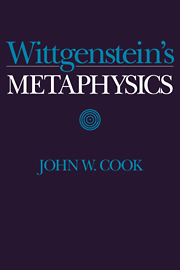Book contents
- Frontmatter
- Contents
- Preface
- List of Abbreviations
- Introduction
- Part I From Idealism to Pure Realism
- Part II The Metaphysics of Wittgenstein's Later Philosophy
- 7 Wittgenstein's Phenomenalism
- 8 A New Philosophical Method
- 9 Wittgenstein's Behaviorism
- 10 Wittgenstein and Kohler
- Part III Causation and Science in a Phenomenal World
- Part IV Logical Possibilities and the Possibility of Knowledge
- Part V The Past, Memory, and The Private Language Argument
- Name Index
- Subject Index
10 - Wittgenstein and Kohler
Published online by Cambridge University Press: 05 November 2011
- Frontmatter
- Contents
- Preface
- List of Abbreviations
- Introduction
- Part I From Idealism to Pure Realism
- Part II The Metaphysics of Wittgenstein's Later Philosophy
- 7 Wittgenstein's Phenomenalism
- 8 A New Philosophical Method
- 9 Wittgenstein's Behaviorism
- 10 Wittgenstein and Kohler
- Part III Causation and Science in a Phenomenal World
- Part IV Logical Possibilities and the Possibility of Knowledge
- Part V The Past, Memory, and The Private Language Argument
- Name Index
- Subject Index
Summary
In the preceding chapter I promised to provide additional grounds for my claim that Wittgenstein remained a behaviorist in his later years even though his choice of words occasionally suggests otherwise, as when he says that we see another person smile or hear him moan. One might expect a behaviorist to avoid words such as “smile” and “moan” and even to insist that, while we see other bodies move in certain ways, we do not see other people frown or grimace, and to insist also that, while we may hear other bodies make sounds, we don't hear people cry out or answer questions. Wittgenstein, I have suggested, thought that he needn't adhere to such strictures, i.e., that he could reconcile his version of behaviorism with the ways we normally talk about other people (“I saw him smile”), and we will now consider one of his reasons for thinking this. At the same time we will consider a related problem about his phenomenalism, namely, his unapologetic way of using such nouns as “table” and “book” in his philosophical discussions. One might expect a phenomenalist to purge his philosophical remarks of such words, and the fact that Wittgenstein did not do so may suggest that he was not a phenomenalist at all. In this chapter we will find reason to think otherwise.
- Type
- Chapter
- Information
- Wittgenstein's Metaphysics , pp. 135 - 152Publisher: Cambridge University PressPrint publication year: 1994



